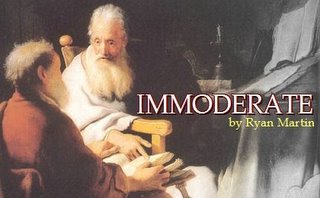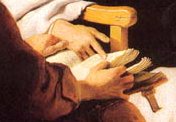A Difficult Christmas text: Matthew 2:15 citing Hosea 11:1 (Part 1)
The hermeneutical significance of Matt 2:15 should not be underestimated. Consider, for example, Walter Kaiser’s remark regarding this passage: “Enter into a discussion of the NT citations of the OT and, before long, someone is bound to raise the example of Matthew’s use of Hos 11:1.”1 In their discussion of “Levels of Meaning,” Klein, Blomberg, and Hubbard use this puzzling passage as their platform.2
Over the next several days (while continuing to post other material), I will discuss the interpretation of this passage. This is not meant to be exhaustive or add to scholarship, but to provide a summary of the different approaches to this hotly debated text, as well as suggest a way of a correct interpretation.
Many who read Matthew quickly notice his emphasis on “fulfillment,” particularly near the beginning of the gospel.3 In the first two chapters alone Matthew uses some derivative of the word πληροω four times to indicate that a certain event in the life of Jesus had fulfilled an OT prophecy.4 Matthew used these OT passages in his attempt to establish the validity of Jesus’ claim as Messiah. He wanted to demonstrate that Jesus was in some way the embodiment of the long awaited Old Testament predictions and promises of a Davidic King.5
The problem is that when Matthew quoted OT passages (particularly Hos 11:1 in 2:15), the fulfillment he saw in them is not quite as evident to modern readers as it was to Matthew.6 In fact, in his attempt to deal with the problem, D. A. Carson states, “Untutored Christians are prone to think of prophecy and fulfillment as something not very different from the straightforward propositional prediction and fulfillment. A close reading of the NT reveals that prophecy is more complex than that.”7
The paragraph wherein the difficult passage lies is found after the pericope of the Magi and their dealings with Herod. Matthew records that at an angel appeared to Joseph and instructed him to take Mary and Jesus to Egypt in order to avoid the jealous massacre that would quickly be ordered by Herod. Matt 2:14-15 says,
In verse 15, the evangelist notes that these events are somehow related to the fulfillment of Hos 11:1. His quotation of the OT passage translates the Hebrew text word for word.8
Matthew’s use of Hosea here is seems problematic on many levels. First, the passage in Hosea cited does not appear to be a prophecy, but “a statement of an historical fact.”9 Second, the passage does not seem to be speaking of the Messiah at all.10 In fact, the entire verse in Hosea says, “When Israel was a child, then I loved him, and called my Son out of Egypt.” So what does the evangelist mean when he says that the holy family’s sojourn in Egypt is a fulfillment of Hosea?
____________
1The Uses of the Old Testament in the New (Chicago: Moody Press, 1985), 43.
2William W. Klein, Craig L. Blomberg, and Robert L. Hubbard, Jr. Introduction to Biblical Interpretation (Dallas: Word, 1993), 120ff.
3William Hendrickson observes, “In general it can be said that the purpose of this Gospel was fully to win the Jews for Christ; that is, to gain those still unconverted and to strengthen those already converted. . . . In order to achieve [this goal] the emphasis throughout is placed on the fact that Jesus is indeed the long awaited Messiah of the Hebrew Scriptures” (New Testament Commentary: Matthew [Grand Rapids: Baker, 1973], 97).
4Of course, many other additional allusions to the OT can be found in these chapters. Matthew uses πληροω in the sense of “fulfillment” of prophecy thirteen different times in his gospel. BDAG notes that πληροω can mean “to bring to a designed end, fulfill,” and that the particular nuance of these uses in Matthew should be understood as “the fulfillment of divine predictions or promises.” When used in this sense, the word is almost always found in the passive tense: “be fulfilled” (828d-829a).
5The seemingly standardized introduction of the formula quotations (“fulfillment” passages) in Matthew, coupled with the fact that each of the OT passages quoted are to some extent removed from the standard LXX have made some scholars wonder if these are not the unique personal reflections of the author. Thus they have become known as the Reflexionszitate. (D. A. Carson, Matthew. ed. Frank E. Gaebelein [Expositor’s Bible Commentary 8; Grand Rapids: Zondervan, 1984], 27).
6Richard Longenecker observed that “the quotations within [Matthew] the Evangelist’s editorial comments . . . are distinctive not only in their introductory formulae and their textual variants, but also in their oft-times applications” (Biblical Exegesis in the Apostolic Period [Grand Rapids: Eerdmans, 1975], 140).
7Matthew, 27.
8Robert Gundry, The Use of the Old Testament in St. Matthew’s Gospel (Leiden: Brill, 1975), 93. The LXX reads εξ Αιγυνπτου μετεκανλεσα τα τεκνα αυτου.
9Alfred Plummer, An Exegetical Commentary on the Gospel According to Matthew (Grand Rapids: Eerdmans, 1956), 17.
10William LaSor may have stated the problem most severely when he said, “The literal meaning of Hosea 11:1 . . . does not seem to give us any basis for such a fulfillment. Hosea is clearly talking about the exodus of Israel from Egypt.. . . If there is any lingering desire on our part to make this apply to Jesus, we are suddenly faced by the words that follow immediately: ‘the more I called them, the more they went from me; they kept sacrificing to the Baals, and burning incense to idols.’” (“Prophecy, Inspiration and Sensus Plenior” Tyndale Bulletin 29 [1978]: 56).
Over the next several days (while continuing to post other material), I will discuss the interpretation of this passage. This is not meant to be exhaustive or add to scholarship, but to provide a summary of the different approaches to this hotly debated text, as well as suggest a way of a correct interpretation.
Many who read Matthew quickly notice his emphasis on “fulfillment,” particularly near the beginning of the gospel.3 In the first two chapters alone Matthew uses some derivative of the word πληροω four times to indicate that a certain event in the life of Jesus had fulfilled an OT prophecy.4 Matthew used these OT passages in his attempt to establish the validity of Jesus’ claim as Messiah. He wanted to demonstrate that Jesus was in some way the embodiment of the long awaited Old Testament predictions and promises of a Davidic King.5
The problem is that when Matthew quoted OT passages (particularly Hos 11:1 in 2:15), the fulfillment he saw in them is not quite as evident to modern readers as it was to Matthew.6 In fact, in his attempt to deal with the problem, D. A. Carson states, “Untutored Christians are prone to think of prophecy and fulfillment as something not very different from the straightforward propositional prediction and fulfillment. A close reading of the NT reveals that prophecy is more complex than that.”7
The paragraph wherein the difficult passage lies is found after the pericope of the Magi and their dealings with Herod. Matthew records that at an angel appeared to Joseph and instructed him to take Mary and Jesus to Egypt in order to avoid the jealous massacre that would quickly be ordered by Herod. Matt 2:14-15 says,
“When [Joseph] arose, he took the young child and his mother by night, and
departed into Egypt: And was there until the death of Herod: that it might be
fulfilled which was spoken by the prophet, saying, “Out of Egypt have I called
my son" (ESV).
In verse 15, the evangelist notes that these events are somehow related to the fulfillment of Hos 11:1. His quotation of the OT passage translates the Hebrew text word for word.8
Matthew’s use of Hosea here is seems problematic on many levels. First, the passage in Hosea cited does not appear to be a prophecy, but “a statement of an historical fact.”9 Second, the passage does not seem to be speaking of the Messiah at all.10 In fact, the entire verse in Hosea says, “When Israel was a child, then I loved him, and called my Son out of Egypt.” So what does the evangelist mean when he says that the holy family’s sojourn in Egypt is a fulfillment of Hosea?
____________
1The Uses of the Old Testament in the New (Chicago: Moody Press, 1985), 43.
2William W. Klein, Craig L. Blomberg, and Robert L. Hubbard, Jr. Introduction to Biblical Interpretation (Dallas: Word, 1993), 120ff.
3William Hendrickson observes, “In general it can be said that the purpose of this Gospel was fully to win the Jews for Christ; that is, to gain those still unconverted and to strengthen those already converted. . . . In order to achieve [this goal] the emphasis throughout is placed on the fact that Jesus is indeed the long awaited Messiah of the Hebrew Scriptures” (New Testament Commentary: Matthew [Grand Rapids: Baker, 1973], 97).
4Of course, many other additional allusions to the OT can be found in these chapters. Matthew uses πληροω in the sense of “fulfillment” of prophecy thirteen different times in his gospel. BDAG notes that πληροω can mean “to bring to a designed end, fulfill,” and that the particular nuance of these uses in Matthew should be understood as “the fulfillment of divine predictions or promises.” When used in this sense, the word is almost always found in the passive tense: “be fulfilled” (828d-829a).
5The seemingly standardized introduction of the formula quotations (“fulfillment” passages) in Matthew, coupled with the fact that each of the OT passages quoted are to some extent removed from the standard LXX have made some scholars wonder if these are not the unique personal reflections of the author. Thus they have become known as the Reflexionszitate. (D. A. Carson, Matthew. ed. Frank E. Gaebelein [Expositor’s Bible Commentary 8; Grand Rapids: Zondervan, 1984], 27).
6Richard Longenecker observed that “the quotations within [Matthew] the Evangelist’s editorial comments . . . are distinctive not only in their introductory formulae and their textual variants, but also in their oft-times applications” (Biblical Exegesis in the Apostolic Period [Grand Rapids: Eerdmans, 1975], 140).
7Matthew, 27.
8Robert Gundry, The Use of the Old Testament in St. Matthew’s Gospel (Leiden: Brill, 1975), 93. The LXX reads εξ Αιγυνπτου μετεκανλεσα τα τεκνα αυτου.
9Alfred Plummer, An Exegetical Commentary on the Gospel According to Matthew (Grand Rapids: Eerdmans, 1956), 17.
10William LaSor may have stated the problem most severely when he said, “The literal meaning of Hosea 11:1 . . . does not seem to give us any basis for such a fulfillment. Hosea is clearly talking about the exodus of Israel from Egypt.. . . If there is any lingering desire on our part to make this apply to Jesus, we are suddenly faced by the words that follow immediately: ‘the more I called them, the more they went from me; they kept sacrificing to the Baals, and burning incense to idols.’” (“Prophecy, Inspiration and Sensus Plenior” Tyndale Bulletin 29 [1978]: 56).





0 Comments:
Post a Comment
<< Home